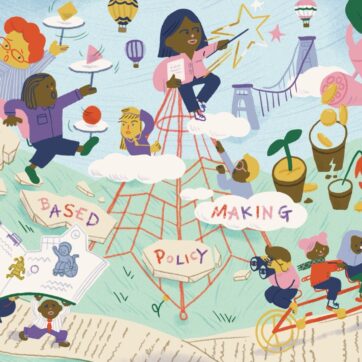What counts as evidence in policymaking? Over 4 years, CAPE has worked to improve the ways academic evidence can be used in policymaking at all levels of government. We have also considered how to better integrate academic with other forms of evidence, including that from communities and third sector organisations. This is critical if we are to ensure that addressing policy problems doesn’t become merely a technocratic exercise, but delivers meaningful change for people.
Our collaborative project with the Institute for Community Studies (ICS) at The Young Foundation brought together people from academia, local government and community organisations in three places around the UK. We have now published a report, drawing on learning from the project, which explores how to create co-production between academics, local government and community organisations to tackle local policy problems.
The project took as its starting point two premises: that understanding policy problems requires input from communities to understand how policy affects people; and that identifying solutions should be done collaboratively with those involved in delivering them and who stand to benefit. We wanted to understand how academic expertise could be brought together with other local actors to identify and address local policy problems and develop responses to them.
What did we do?
The project involved working with three place-based teams to identify and address a local policy problem. Over three months the ICS delivered a ‘learning journey’ which established principles of co-production and ways of working, and provided space to explore and unpack the policy problem each team wanted to address. At the end of this training, teams were provided with £25,000 to address policy challenges they had identified through ‘mini-projects’.
Crucially, no outcomes were specified in advance. Teams were encouraged to iteratively develop their project as discussions and work progressed. The seed funding grants were similarly provided on an entirely flexible basis, to be deployed in the way teams determined best. As one person put it: “The flexibility of the funding allowed people to listen to the community.”
Funding like this – provided flexibly but with guidance from ICS and CAPE – with no remit as to what question(s) need to be answered, project(s) should be delivered, or what success(es) looks like, is rare. Yet we found it was hugely valuable in creating the necessary conditions for the place-based teams to try something new, learn on the go, and develop new insights into tricky policy problems.
It was noteworthy that all three mini-projects ended up concerned with the experiences of young people – via families experiencing in-work poverty, as people experiencing loneliness and social isolation, and as a politically disenfranchised demographic. This perhaps reflects that young people are often overlooked in policy frameworks and services; and that the solutions needed to tackle some of the issues they face can fall between policy silos. The projects also all highlighted the need for social infrastructure or trusted community institutions to tackle the different problems which has been identified by young people.
More information about each mini-project and their achievements is covered in the report.
What did we learn?
The different projects all started from the same premise of co-creating a problem statement and then co-producing a solution. From this approach, we have identified five common insights which emerged from shared learning across the projects.
Stronger together: Teams valued being able to work in a cohort with other projects and share challenges along the way. They also welcomed the focus on a practical problem for driving deeper collaboration with local partners, as a way of building genuine shared activity. Across the project, the complementary strengths of partners were apparent: with universities acting as a source of expertise and ‘credibility’ and providing convening capacity; local government bringing insights across a breadth of policy domains and an understanding of both on-the-ground service delivery and broader policy frameworks; and the third sector identifying ‘gaps’ in current policy and service provision and extensive networks.
Stepping up and stepping back: at different points of the projects, different expertise came to the fore. At times, academics had to ‘step back’ from their deep subject expertise and allow room for other contributors to take the lead. Understanding who was best placed to take on a particular delivery role was important to enable different forms of knowledge and expertise together through the co-productive approach.
Learning by doing: teams frequently emphasised the value of being able to learn through trying things out, with a sense that there were no right answers and no such thing as failure. Even where interventions didn’t ‘work’ as anticipated, they provided valuable learning, enabled collaborative evaluation, and supported the development of relationships. Establishing a collaborative tone and a space where there is permission to try new things and to ‘fail’ helped the project teams to feel empowered. As one person put it: “To hear that we could get things wrong was liberating. To have that from the start let us put preconceived ideas out the door and see what happens.”
The importance of capacity: buy-in from senior leadership, alongside time, were key enablers for this work. Conversely, a lack of funding and time served as a barrier. Having capacity to build relationships and trust – both amongst teams and with wider actors – was also crucial. In an operational sense, capacity to manage projects that didn’t neatly fit into pre-existing systems was also important; there is some irony to resource-strapped community organisations often having to take on management that universities as larger and less agile institutions couldn’t accommodate.
The value of ‘layered’ coproduction: The development of the projects revealed an unplanned ‘layering’ of co-production. Early discussions and initial problem definition amongst stakeholders set out a strategic need, with problems aligned to policy frameworks. This was succeeded by co-producing solutions and actions with delivery partners, service users, and partners ; with lived experience to inform delivery. This layering meant that project co-production was focused on meaningful action.
What we recommend others do
Our report identifies 7 key recommendations that we hope can inform future work and support productive collaboration to address local challenges.
1. Create conditions that support knowledge-sharing: The three case studies emphasised the importance of creating team environments that allow for diverse knowledge – traditional, local, experiential – to be shared effectively and integrated into project delivery.
2. Invest in relationship-building: This requires a recognition of the different roles co-production partners can play, and investment in relationship-building.
3. Learn from experience: Funding that invests in teams, rather than desired outcomes, creates flexibility for teams to learn and innovate from both successes and failures.
4. Connect institutions and communities: The ‘layered’ approaches that emerged in this project, where local case study teams deployed co-production methods to work directly with those holding lived experience of the issues at hand, is an exciting model that can deepen relationships between institutions and local communities.
5. Leverage university assets: Universities can better leverage their institutional assets towards co-production by introducing more flexible pay structures for their staff, greater willingness to delegate funding and delivery, and greater emphasis internally on the civic impact of engaged academics.
6. Address policy challenges that cut across silos: For local government, co-production is a unique opportunity to identify policy challenges that cut across departments and mobilise the capacity of a local consortium to address them. To enable this activity, local governments could better communicate how external partners can best approach and engage with them.
7. Value third sector organisations: they play a crucial role in setting out community needs at a strategic level and supporting the engagement of individuals with lived experience of the subject being explored.
This kind of work isn’t easy and it doesn’t lead to overnight transformation. What it illustrates is that providing time, space and resource to bring people together to build collective understanding of problems and co-develop solutions iteratively acts as a powerful catalyst for new ways of thinking and working to start to address intractable and overlooked policy problems at local level.


